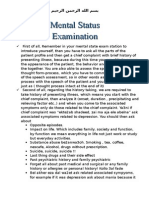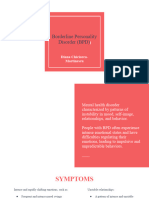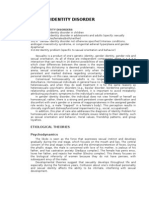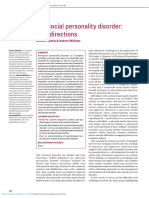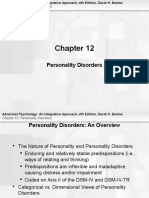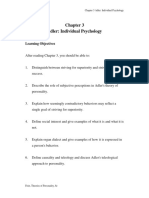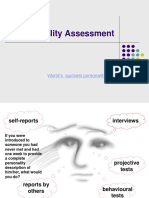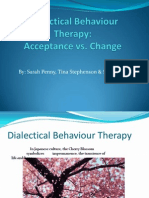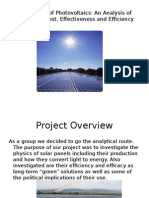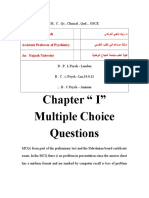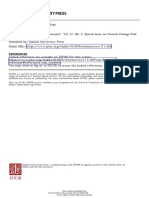Personality Disorder and Addiction
Personality Disorder and Addiction
Uploaded by
raj1090Copyright:
Available Formats
Personality Disorder and Addiction
Personality Disorder and Addiction
Uploaded by
raj1090Copyright
Available Formats
Share this document
Did you find this document useful?
Is this content inappropriate?
Copyright:
Available Formats
Personality Disorder and Addiction
Personality Disorder and Addiction
Uploaded by
raj1090Copyright:
Available Formats
Personality Disorders and Substance Use Disorders
Whats the connection?
1
What is a Personality Disorder?
According to the American Psychiatric Association (APA), a personality disorder exists when an individuals personality traits are inflexible and maladaptive and cause either significant impairment in social or occupational functioning or subjective distress.
What causes Personality Disorders?
There are various theories, but the leading ones hold that normal, healthy childhood development gets interrupted in some significant manner; One type of scenario in which this occurs is that of abuse or neglect including severe emotional, physical, or sexual abuse. One perspective is that a personality disorder is like a badge of courage because it indicates that someone has survived much hurt.
Reframing the problem of Personality Disorders
One way to understand personality disorders is that the person coped in the best way they knew how, in response to difficult circumstances, and at that past time (typically during childhood), it helped them to survive. (i.e., ADAPTIVE)
Reframing the problem of Personality Disorders
However, those old coping mechanisms tend not to work very well in adulthood, and have become ineffective, or MALADAPTIVE.
What are the different types of personality disorders?
Cluster A
Paranoid Personality Disorder Schizoid Personality Disorder Schizotypal Personality Disorder Antisocial Personality Disorder Borderline Personality Disorder Histrionic Personality Disorder Narcissistic Personality Disorder
Avoidant Personality Disorder Dependent Personality Disorder Obsessive-Compulsive Personality Disorder
Cluster B
Cluster C
Common Characteristics of Personality Disorders
Pattern of problematic relationships
Tendency to blame difficulties on others, or on bad luck A lack of personal responsibility
Impaired ability to learn from previous experience
Personality Disorders and Addiction
Pattern of problematic relationships
In active addiction, a persons primary relationship is with their substance of choice all other relationships come second to that one.
Personality Disorders and Addiction
Tendency to blame difficulties on others, or on bad luck
Working through the symptom of denial, or working from a state of precontemplation to an action stage of change is one key to recovery success
Personality Disorders and Addiction
A lack of personal responsibility
Owning personal responsibility for actively participating in ones own recovery is another key to recovery success (12-Step inventories & amends-making)
10
Personality Disorders and Addiction
Impaired ability to learn from previous experience
Doing the same thing over and over again, and expecting a different result description of addictive insanity
11
Cluster B Personality Disorders
Antisocial
Personality Disorder
Personality Disorder
Borderline Histrionic
Personality Disorder
Narcissistic
12
Personality Disorder
Antisocial Personality Disorder (3% males, 1% females)
A pattern of disregard for, and violation of, the rights of others
Over 30% prevalence in substance abuse treatment settings; most common with male alcoholics, mean drunks
13
Antisocial Personality Disorder 3 or more traits
1.
Failure to conform to social norms re: lawful behavior as in repeatedly performing acts that are grounds for arrest
Deceitfulness, as in repeated lying, using aliases, or conning others
2.
3.
Impulsivity or failure to plan ahead
14
Antisocial Personality Disorder 3 or more traits
4.
Irritability and aggressiveness, as in repeated assaults or fighting
Reckless disregard for safety of self or others Consistent irresponsibility, as in repeated failure to maintain employment, or to honor $ obligations Lack of remorse re: mistreating others
5.
6.
7.
15
Borderline Personality Disorder (2%)
a pattern of instability in interpersonal relationships, selfimage
30-60% of persons diagnosed with personality disorders end up with this diagnosis
16
Borderline Personality Disorder 5 or more traits
1. 2.
Frantic efforts to avoid abandonment
Pattern of unstable/intense relationships Unstable self-image, sense of self Impulsivity that is potentially selfharmful Recurrent suicidal behavior, gestures, threats, or self-mutilating behavior
3. 4.
5.
17
Borderline Personality Disorder 5 or more traits
6. 7. 8.
Emotional instability, over-reactivity
Chronic feelings of emptiness
Inappropriate, intense anger or anger control problems
Transient, stress-related paranoid ideation or severe dissociative symptoms
9.
18
Histrionic Personality Disorder (2-3%)
a pattern of excessive emotionality and attention seeking
19
Narcissistic Personality Disorder (<1%)
a pattern of grandiosity, need for admiration, and lack of empathy
20
Goods News / Bad News
Unlike many other disorders that are chronic or ongoing, personality disorders are resolvable / curable
The process of resolving a personality disorder usually involves hard work over an extended period of time
21
Dialectical Behavior Therapy treatment leads to changes in . . .
Ways of thinking
Ways of managing emotions Ways of relating to others
Ways of dealing with distress
22
Dual Recovery domains
Thinking Emotions
Dealing with others
Dealing with discomfort
Stinkin thinkin Emotional binging (ex. self-pity) can precede substance binging Conflict / avoidance, resentments Alternatives to using to manage distress
23
Cluster A Personality Disorders
Paranoid
Personality Disorder Personality Disorder Personality
Schizoid
Schizotypal
Disorder
24
Paranoid Personality Disorder (2.5%)
a pattern of distrust and suspiciousness such that others motives are interpreted as malevolent
25
Schizoid Personality Disorder (<1%)
a pattern of detachment from social relationships, and a restricted range of emotional expression
26
Schizotypal Personality Disorder (3%)
a pattern of acute discomfort in close relationships, as well as cognitive or perceptual distortions, and eccentricities of behavior
27
Cluster C Personality Disorders
Avoidant
Personality Disorder Personality Disorder
Dependent
Obsessive-Compulsive
Personality Disorder
28
Avoidant Personality Disorder (<1%)
a pattern of social inhibition, feelings of inadequacy, and hypersensitivity to negative evaluation
29
Dependent Personality Disorder (?%)
a pattern of submissive and clinging behavior related to an excessive need to be taken care of
30
Obsessive-Compulsive Personality Disorder (1%)
a pattern of preoccupation with orderliness, perfectionism, and control
31
You might also like
- Case Presentation PBL 12 (Bipolar Disorder)Document65 pagesCase Presentation PBL 12 (Bipolar Disorder)Rhomizal Mazali83% (6)
- Social Anxiety FormulationDocument2 pagesSocial Anxiety FormulationBeatrice2254No ratings yet
- Chapter 6: Somatoform and Dissociative DisordersDocument19 pagesChapter 6: Somatoform and Dissociative DisordersEsraRamos100% (2)
- Conduct Disorder CBTDocument11 pagesConduct Disorder CBTprabhaNo ratings yet
- 4 - Kiehn, B & Swales, M. (2007) - An Overview of Dialectical Behaviour Therapy in The Treatment ofDocument9 pages4 - Kiehn, B & Swales, M. (2007) - An Overview of Dialectical Behaviour Therapy in The Treatment ofAnastasiya PlohihNo ratings yet
- Mental Status ExamDocument8 pagesMental Status ExamKhaled GharaibehNo ratings yet
- Cluster B PresentationDocument15 pagesCluster B PresentationMahnoor MirzaNo ratings yet
- Substance Abuse PresentationDocument50 pagesSubstance Abuse PresentationGabrielle Katt100% (1)
- SureFire CPR NRP Study GuideDocument18 pagesSureFire CPR NRP Study GuidelykaNo ratings yet
- Epidemiology of Mental IllnessDocument30 pagesEpidemiology of Mental IllnessAtoillah IsvandiaryNo ratings yet
- Chapter 9 Personality DisordersDocument35 pagesChapter 9 Personality DisordersJuhi NathNo ratings yet
- Mary C. Gomez, MD, DPBP, FPPA Child, Adolescent, Adult PsychiatristDocument66 pagesMary C. Gomez, MD, DPBP, FPPA Child, Adolescent, Adult Psychiatristxiejie22590No ratings yet
- Personality Disorder TMHCDocument193 pagesPersonality Disorder TMHCHARSHITA JAIN 21223053100% (1)
- Borderline Personality Disorder (BPD)Document17 pagesBorderline Personality Disorder (BPD)crochetmamuNo ratings yet
- Rather Than Desirable, Outcomes.: What Is Impulsivity?Document7 pagesRather Than Desirable, Outcomes.: What Is Impulsivity?Suresh LukoseNo ratings yet
- Cognitive DistortionsDocument1 pageCognitive DistortionsTransformNo ratings yet
- Sigmund Freud Psychosexual Theory Kohlberg's Theory of MoralityDocument1 pageSigmund Freud Psychosexual Theory Kohlberg's Theory of MoralityMary SutingcoNo ratings yet
- Reactive Attachment DisorderDocument28 pagesReactive Attachment Disorderkadingermft100% (1)
- Assessment Questionnaire GuideDocument7 pagesAssessment Questionnaire GuideKasandra Dawn Beriso100% (1)
- Gender Identity DisorderDocument12 pagesGender Identity Disorderapi-3797941100% (1)
- Defense Mechanisms in Personality DisordersDocument71 pagesDefense Mechanisms in Personality DisordersIsha AroraNo ratings yet
- Child Psychotherapy. Core ItemsDocument82 pagesChild Psychotherapy. Core ItemsScribdTranslationsNo ratings yet
- Lecture 5-Mood disordersPDF - 240228 - 203457Document47 pagesLecture 5-Mood disordersPDF - 240228 - 203457hui xin ng100% (1)
- PsychiatryDocument23 pagesPsychiatryNaveenKumarNo ratings yet
- Defense Mechanisms and Personality DisordersDocument32 pagesDefense Mechanisms and Personality DisordersHigo100% (2)
- Cognitve Behavior TherapyDocument36 pagesCognitve Behavior TherapyvinodksahuNo ratings yet
- Aggression QuestionnaireDocument2 pagesAggression QuestionnaireMichelle LanguianNo ratings yet
- Co-Occurring DisordersDocument91 pagesCo-Occurring DisordersEmilyNo ratings yet
- Module 4 - Part 3 - SED 2100Document15 pagesModule 4 - Part 3 - SED 2100kylieNo ratings yet
- Classification in DSM-5Document7 pagesClassification in DSM-5RintuNo ratings yet
- Antisocial Personality DisorderDocument12 pagesAntisocial Personality DisorderMaría Isabel Trujillo MayaNo ratings yet
- Personality DisorderDocument11 pagesPersonality DisorderELLFONSO TAN MUN HONG A19HM0023No ratings yet
- Antisocial Personality DisorderDocument9 pagesAntisocial Personality DisorderNoeh Ella de Chavez100% (1)
- Case StudyDocument3 pagesCase StudyRatish CdnvNo ratings yet
- The Basics of DBTDocument14 pagesThe Basics of DBTLeidy GuevaraNo ratings yet
- Chapter 12: Personality DisordersDocument28 pagesChapter 12: Personality DisordersEsraRamosNo ratings yet
- Mood Disorder Depression and Bipolar DisorderDocument58 pagesMood Disorder Depression and Bipolar DisorderYousef JafarNo ratings yet
- Alfred Adler SummaryDocument11 pagesAlfred Adler SummaryJunna Alitagtag100% (1)
- Define Personality Disorders According To The DSM-IV: ParanoidDocument4 pagesDefine Personality Disorders According To The DSM-IV: Paranoidkep1313No ratings yet
- Borderline Personality DisorderDocument6 pagesBorderline Personality DisorderPersephona13No ratings yet
- Psychiatric Disorders of Childhood PDFDocument55 pagesPsychiatric Disorders of Childhood PDFJenny Wong100% (1)
- Defense MechanismsDocument3 pagesDefense MechanismsPatrick Formoso100% (3)
- 5 Personality Assessment PDFDocument21 pages5 Personality Assessment PDFJimmie KimaniNo ratings yet
- Schizophrenia: Symptoms of Schizophrenia (ICD-10)Document11 pagesSchizophrenia: Symptoms of Schizophrenia (ICD-10)Kayleigh EdwardsNo ratings yet
- Cognitive Distortions (Errors)Document4 pagesCognitive Distortions (Errors)Sikandar HayatNo ratings yet
- Understanding-Ocd 2016 v2Document27 pagesUnderstanding-Ocd 2016 v2Samanjit Sen Gupta100% (1)
- Parts: of PsycheDocument10 pagesParts: of PsycheFlower100% (2)
- Adult Attachment ScaleDocument10 pagesAdult Attachment ScaleSasu NicoletaNo ratings yet
- Intervention, Management of HallucinationDocument52 pagesIntervention, Management of HallucinationAshish_Singh_5126100% (1)
- Cluster A: The Odd and Eccentric ClusterDocument33 pagesCluster A: The Odd and Eccentric ClusteralEXISTNo ratings yet
- Borderline ScreeningDocument3 pagesBorderline ScreeningAlexandreDuarteGiganteNo ratings yet
- Histrionic Personality Disorder JhonyDocument17 pagesHistrionic Personality Disorder Jhonyjhony c. benedictaNo ratings yet
- Personality Disorders in The Workplace.1021131Document16 pagesPersonality Disorders in The Workplace.1021131ArchanaNo ratings yet
- Personality Disorders PDFDocument35 pagesPersonality Disorders PDFABHINAV100% (1)
- DBT PresentationDocument7 pagesDBT Presentationapi-251536652No ratings yet
- Reactive Attachment Disorder & Trauma, A Powerpoint PresentationDocument23 pagesReactive Attachment Disorder & Trauma, A Powerpoint PresentationJane Gilgun100% (2)
- 2b - Personality DisordersDocument27 pages2b - Personality DisordersaldreinNo ratings yet
- Teenage AnxietyDocument34 pagesTeenage Anxietyamit100% (1)
- What Is Fight or Flight'? When We Perceive A Threat, Our Bodies Go IntoDocument5 pagesWhat Is Fight or Flight'? When We Perceive A Threat, Our Bodies Go IntoHarold LowryNo ratings yet
- SCHIZOPHRENIADocument4 pagesSCHIZOPHRENIAFast MasoodNo ratings yet
- Paranoid Personality Disorder 1Document37 pagesParanoid Personality Disorder 1NimmyNo ratings yet
- Cognitive Thinking ErrorsDocument2 pagesCognitive Thinking ErrorsParamjeet Singh KhuranaNo ratings yet
- Comprehensive Handbook of Psychological Assessment, Volume 1: Intellectual and Neuropsychological AssessmentFrom EverandComprehensive Handbook of Psychological Assessment, Volume 1: Intellectual and Neuropsychological AssessmentNo ratings yet
- Solar Cell PresentationDocument26 pagesSolar Cell Presentationraj1090No ratings yet
- Effects of Particle SizeDocument3 pagesEffects of Particle Sizeraj1090No ratings yet
- Spintonix FundamentalsDocument91 pagesSpintonix Fundamentalsraj1090No ratings yet
- DocumentDocument2 pagesDocumentraj1090No ratings yet
- Articles 10Document9 pagesArticles 10NAWAL AWAD AL-ANAZZINo ratings yet
- Professional Ethics in PsychologyDocument2 pagesProfessional Ethics in Psychologynajeeb ullahNo ratings yet
- Case StudyDocument11 pagesCase Studyapi-400548155No ratings yet
- Social Work Dissertations PDFDocument5 pagesSocial Work Dissertations PDFWhereCanIFindSomeoneToWriteMyCollegePaperCanada100% (1)
- Professor Solove'S Taxonomy of Privacy: Adapted From Daniel J. Solove, U P (Harvard University Press 2008)Document3 pagesProfessor Solove'S Taxonomy of Privacy: Adapted From Daniel J. Solove, U P (Harvard University Press 2008)Abu SaleahNo ratings yet
- Bipolar DisorderDocument65 pagesBipolar DisorderEffectively Creative GroupNo ratings yet
- Substance Use Stages of ChangeDocument2 pagesSubstance Use Stages of ChangeRiza Zahara100% (2)
- Claret College of Isabela Roxas Avenue, Isabela City Senior High School UnitDocument5 pagesClaret College of Isabela Roxas Avenue, Isabela City Senior High School UnitAMIDA ISMAEL. SALISANo ratings yet
- The Cambridge Medical Ethics Workbook CADocument1 pageThe Cambridge Medical Ethics Workbook CAmaha.shoo.92No ratings yet
- Activity 1Document2 pagesActivity 1MIGUEL MORANo ratings yet
- BOSTONDocument2 pagesBOSTONLyreb HawkNo ratings yet
- Irbd 2011Document5 pagesIrbd 2011Meenakshi JainNo ratings yet
- Burns and TruogDocument9 pagesBurns and TruogSANDHYANo ratings yet
- Toledo West PDFDocument175 pagesToledo West PDFSeinsu ManNo ratings yet
- Schizoaffective With Bipolar DisordersDocument14 pagesSchizoaffective With Bipolar DisordersNaomi MasudaNo ratings yet
- Code of Medical EthicsDocument33 pagesCode of Medical Ethicsp1843dNo ratings yet
- Bioethics SAS 6Document7 pagesBioethics SAS 6Mackie MoralesNo ratings yet
- ADHD - Rejection-Sensitive DysphoriaDocument3 pagesADHD - Rejection-Sensitive DysphoriaGrantHeathcote100% (3)
- Py VotersDocument132 pagesPy VotersDorie Ann Vicente GregorioNo ratings yet
- Aa Support Group ObservationDocument6 pagesAa Support Group Observationapi-302499446100% (3)
- Leskovac Nur 460 PGC Reflection PaperDocument9 pagesLeskovac Nur 460 PGC Reflection Paperapi-527774673No ratings yet
- Bothics MCQSDocument7 pagesBothics MCQSHabib UllahNo ratings yet
- Chapter " I" Multiple Choice QuestionsDocument56 pagesChapter " I" Multiple Choice QuestionsFiras AnayaNo ratings yet
- Diagnostic and Statistical Manual of Mental Disorders: Psychopathy (Document30 pagesDiagnostic and Statistical Manual of Mental Disorders: Psychopathy (manoj kumarNo ratings yet
- 2012 Williston - Climate Change and Radical HopeDocument23 pages2012 Williston - Climate Change and Radical HopeJose rosaNo ratings yet
- Optimising The Documentation PracticesDocument4 pagesOptimising The Documentation PracticesJENIFER KARINA PUTZ LORENZINo ratings yet





